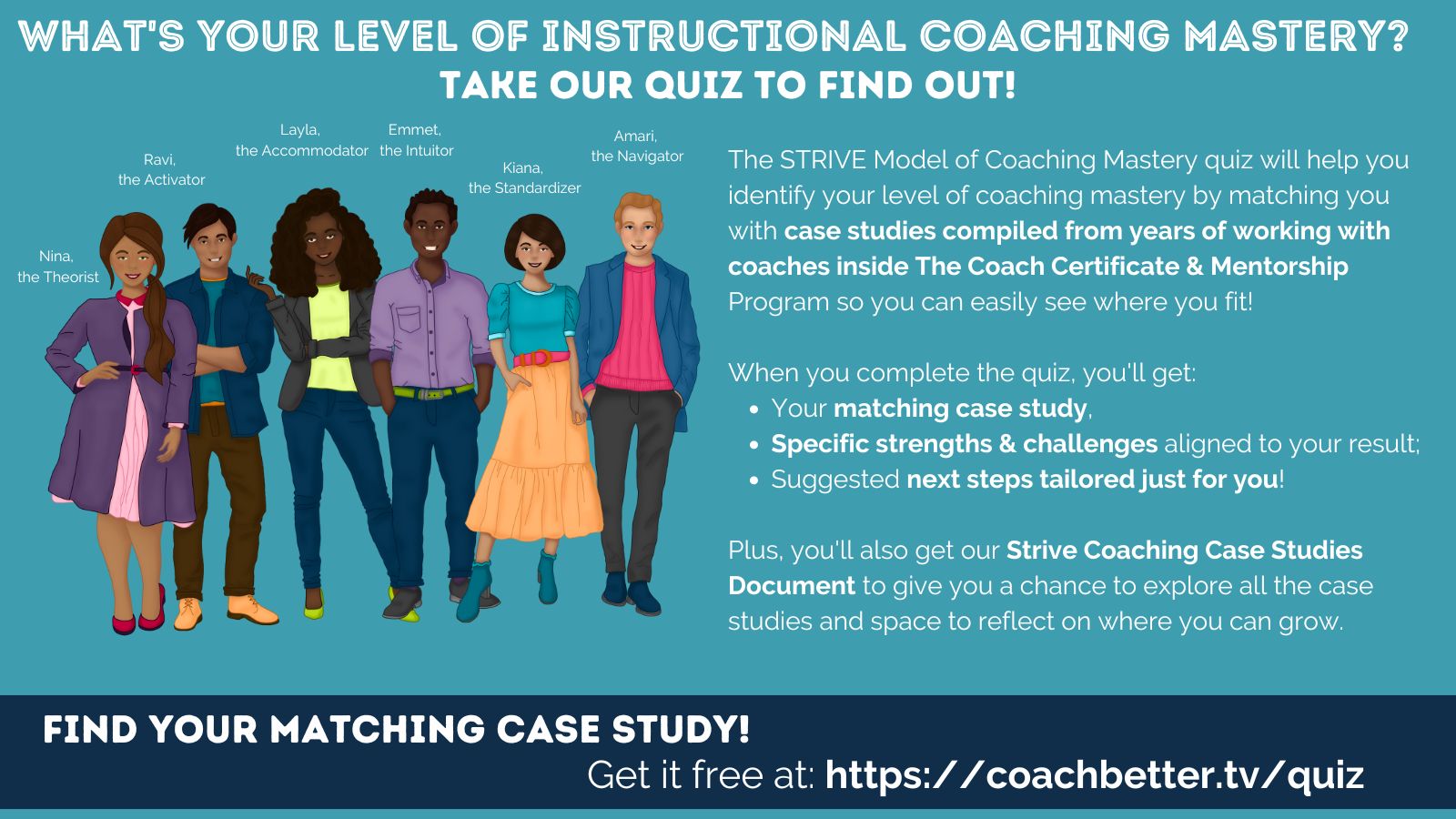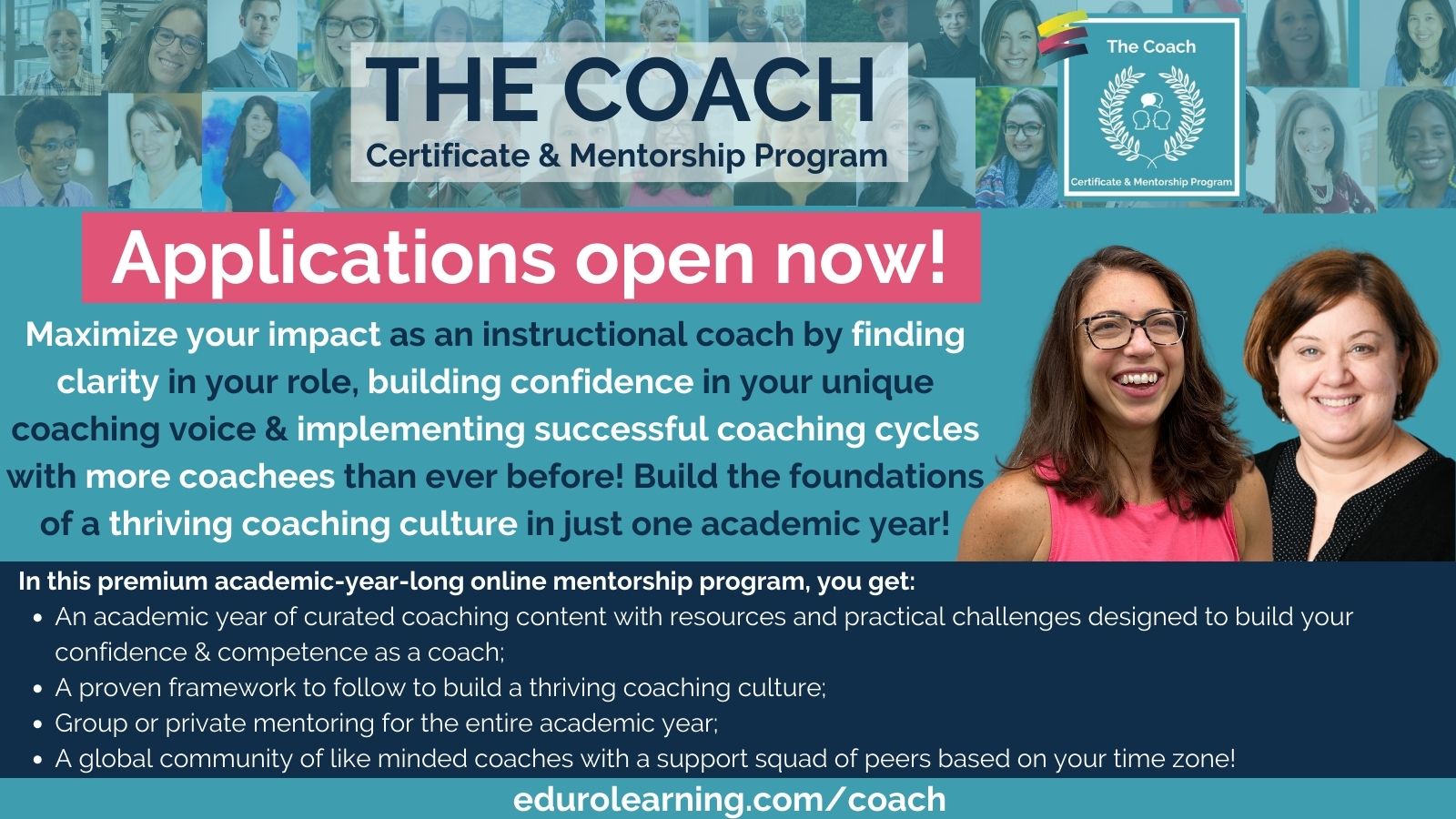We know that teachers are busy people, and yet, we want them to invest their time and energy in coaching.
We know our colleagues want to be the best teachers they can be, but sometimes they still don’t choose to engage in coaching cycles with us. Why is that?
Oftentimes it’s because they may not understand exactly what the coaching process looks like, exactly how it can support them, and what we as coaches can do with them that would be any better than what they can do on their own.
Communicating (or “marketing”) all of those services is part of YOUR job as a coach.
If we want our colleagues to engage deeply in coaching cycles with us, to see us as an asset to their professional learning, it’s important that they understand what coaching is – and how it can work for them.
To do that, we have to take a proactive approach in communicating our role.
This means we need to communicate all of that to our coachees on a consistent basis. And because teachers are so busy, we need to communicate it again and again in many different ways. You might feel a bit like a broken record, but it’s likely that your very busy colleagues are not listening as closely, or paying as much attention to what you’re doing, and saying, regarding coaching, as you are.
Think about the amount of attention that people are paying to the magazines when they’re on line to pay in a grocery store – that may be the amount of attention that teachers have for your coaching promotions on a daily basis.
Sometimes we can get stuck in the trap of thinking that “no one wants to be coached”, and “I’m tired of repeating myself”, and although we might be facing some true reluctance for a variety of other reasons, often it’s genuinely because teachers may not know what you do, how you do it & why it might be right for them, right now.
Don’t let that feeling of “reluctance” get you down. Don’t let that feeling of repeating yourself stop you. The reality is that talking about our coaching services once at the beginning of the year is simply not enough – and once at the launch of your coaching program is DEFINITELY not enough.
Think about the amount of teacher turnover you might’ve had since the last time you talked about coaching, think about all of the things that might’ve happened in your school, in your community, in your teacher’s individual world since the last time you talked about coaching with them. It’s likely you’re going to have to do it a lot more than you want to – and a lot more than feels comfortable at the start.
We need to help our coaches understand that they do need support and that they can get that support from us.
Today’s post is going to focus on 4 ways you can think about communicating your role to your coachees. All of these are featured inside The Coach Certificate and Mentorship Program in Phase 1: Finding Clarity. So if you want to follow this process, and create some of these resources for your teachers – with the support of a mentor and a global cohort of coaches, you can do that with us, in The Coach! Get all the details over at edurolearning.com/coach – and if you want to see a sample week of what The Coach looks like in action, you can grab it at: https://edurolearning.com/coachpreview
What’s YOUR level of coaching mastery?
All coaches go through various stages of coaching mastery. Once you identify where you’re at, you can begin to build the skills needed to move to the next stage.
This quiz is based on real-life case studies compiled from years of working with coaches inside The Coach Certificate & Mentorship Program!
When you receive your results, you’ll also get your matching case study from the STRIVE Case Studies to see where you fit in the stages of coaching mastery.
Ready to tackle your challenges and move on to the next level in YOUR coaching practice?

The STRIVE Model of Coaching Mastery quiz will help you identify your level of coaching mastery by matching you with case studies compiled from years of working with coaches inside The Coach Certificate & Mentorship Program so you can easily see where you fit!
When you complete the quiz, you’ll get:
- Your matching case study,
- Specific strengths & challenges aligned to your result;
- Suggested next steps for each stage;
Plus the Case Study Document includes:
- Case studies leveled by coaching mastery;
- A framework to identify essential stages of professional growth & key areas to focus on in your professional learning;
- Alignment with the THRIVE Model for a Successful Coaching Culture;
- Space for you to reflect & prioritize so you can take action immediately!
You’ll go straight to the Quiz, and get the Case Study Document via email.
4 Steps to Intentionally Communicating Your Role, as a Coach
1: Understand the Stages of Customer Awareness
This concept comes from consumer marketing, but it applies just as well to coaching, because ultimately as coaches, we are marketing our services.
We need to move our teachers from:
- Problem unaware
- Problem aware
- Solution unaware
- Solution aware
- Product aware
Often we start with promoting our coaching (the solution) instead of starting with the problem. If teachers do not see coaching as the solution to their problem, they’re never going to choose to invest in it themselves.
Most often our coachees are operating over here: they’re in problem unaware mode. They’re don’t even realize they have a problem or they’re in a problem aware, but they don’t know the that there’s a solution. And we’re operating way down here talking about our product coaching. We need to move them through all of these phases in our marketing strategy to help them move from problem unaware all the way down to your service, that product of coaching. B
Because if we start by promoting the solution (our coaching), instead of starting with the problem that teachers have, it will be harder to see coaching as a solution to the problem, and they’re never going to choose to invest in the solution we’re providing.
So, how do we do this?
First, we need to make sure clients are aware of our services, but they don’t feel overwhelmed or burdened by them. (And we might need to convince our admin that we need more time to share our services to keep them on teachers’ radar too!). And we need to frame that in their language, so they recognize that it’s a solution to their problem (not just some random service that seems to come from out of nowhere, or worse, forced through compliance).
2: Conduct a Needs Assessment
A strategic way to start is by conducting a needs assessment. It doesn’t have to be a formal survey (although, of course it can be), but whatever opportunity you have to find out what your teachers think they need support with is where you can start. This can even be through individual conversations with specific teachers as part of your relationship building!
As soon as you know what they perceive as their potential challenges, you can start targeting your coaching services at exactly what they need. As you do this, make sure you use their exact language. You likely have “the curse of knowledge” and might describe the same exact issue as a teacher, but using more precise words. Although this may be more exact, it’s not helping them recognize that YOU know and understand what their problem is (because you’re using completely different words).
3: Create a Coaching Menu
Once you know what their perceived needs are, and the language they use, you can create opportunities to share your potential solution: coaching!
This is often a coaching menu, a single page document that identifies the services you provide as a coach in the language of your coachees, targeted to the specific needs they have (like a menu in a restaurant, but all the options are exactly what you want!)
You might find that sharing this menu in a digital format works best in your environment, or giving samples at a faculty meeting is most engaging, or having other teachers share their successes is best. Whatever works in your setting, you’ll want to be sharing the many opportunities that coachees have to work with you, using their language, as possible.
4: Develop Shared Language & Expectations
Help your coachees understand the kinds of services you can provide by making the different kinds of support you offer transparent. Your coaching menu can include additional documentation about the coaching stances of consulting, collaborating and coaching (see more about that in one of our previous episodes about The Coach Approach and our #coachbetter episode with Laura Lipton on the Continuum of Practice for Instructional Coaches).
You might also want to include a description of the coaching cycle, your beliefs & values as a coach, and what coaching is & isn’t to create really clear expectations around your work together.
People need to hear the same message many times before it sticks. Repeating your message more than once is HELPFUL, not harmful. And having multiple ways to engage with that message makes it even more “sticky.”
Although it may feel boring or repetitive for you, having this foundation for your work and your support will become highly appreciated by your coachees and YOU. Being able to have a place to come back to for reference, and to refine over time will help you get better at communicating your role, and build the confidence of teachers to “opt in” to coaching.
If you are doing all 4 of those things on a regular basis, you’re effectively, proactively, intentionally and consistently communicating your role to your coachees. Which of those feels really natural to you? Which is new that you’ll start applying this year? Let me know in the comments! I love to hear from you & see where you’re at in your coaching journey!
Watch the Video
Is it time to be more intentional about communicating your role?
Join The Coach Certificate & Mentorship Program and learn how – with the support of a global community & a framework to follow!
It’s easy to expect teachers to want to be coached – and to understand what coaching is – especially when you have such a clear picture for yourself. But if you are ready to maximize your impact as an instructional coach, if you want to make a bigger impact in teaching and learning at your school, and you want to start having enthusiastic coachees engaged in coaching cycles with you – start being proactive about seeking out clients.
These 4 strategies are a perfect example of the kinds of conversations we have inside The Coach Certificate and Mentorship Program. In Phase 1, we focus on Finding Clarity, so that you can clearly communicate your role – to your teachers and your school leaders. Being clear about your role is the number one way to get more teachers enrolled in coaching cycles with you. Creating documentation and implementing your process is one of the very first tangible products you’re going to create inside The Coach!
Are you ready to work with more teachers in your school? Join us for the next cohort of The Coach Certificate and Mentorship Program so you can start building the skills you need to begin working with more teachers than ever before!

Find all the details at edurolearning.com/coach
We open registration for our annual global cohorts once a year, so make sure to get on our mailing list by opting in to one of our freebies on the page so you’ll be the first to know when our next cohort opens!

Recent Comments